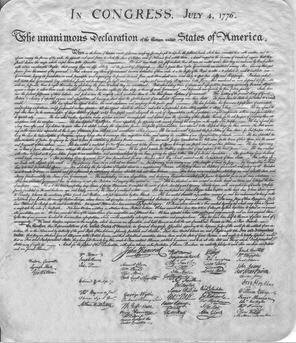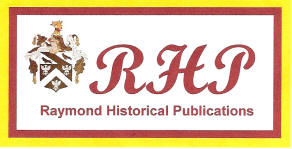|
|
|
Last time: We completed our journey, in 50-year steps, back to the Cambridge Patent of 1761. Now we’ll fill in some of the gaps in the story of Old Cambridge and early America, to reveal the character of the pioneers of freedom and the architects of democracy.
Chapter 11: The Revolution, Opening Gambits - 1763-1776 The ink was drying on the Patent parchment as the French and Indian War wound down; the Treaty of Paris ended the conflict in 1763. To keep peace with the Indians, King George III decreed that no colonist could settle beyond the crest of the Appalachians or past the Adirondacks because he’d station no troops out on the frontier. With a growing population, though, English colonials still streamed out into the Great Lakes area and the Ohio River valley. Furthermore, to defray the cost of the war, beginning in 1764 the Crown began imposing heavy taxes across all the provinces from New Hampshire to Georgia, including the settlements of the Owlkill. These were the Revenue Acts, Stamp Act (stamps affixed to many Colonial exports), and Townshend Act, all lining Great Britain’s treasury and inciting the settlers’ appeals of “No Taxation without Representation”. In 1765 under the auspices of military patents, acreage in the Cambridge area was granted to British officers mustering out of service after the War. Major James Cowden opened the area’s first tavern in a large log cabin south of the present Village of Cambridge, on the Turnpike, the post road between Lansingburg and Rutland. Cowden would soon forsake his allegiance to the Crown for a new cause. The first religious body was formed in the Cambridge area in 1769, a union church of Calvinists, and a cemetery was established that year in Salem that eventually became the final resting place for over a hundred veterans of a war that unknowingly loomed ahead. As the 1770s opened, the colonists began to tire of their dogmatic monarch an ocean away. Voices were raised in protest, yet loyalists (Tories)—largely the gentry who owned and operated the import-export houses, shipbuilding and the like—raised their toasts: “God save the King!” Then a chilling slaughter on a cobbled Boston street sobered up both sides of the aisle. As tensions mounted in the cities, the King’s governors declared in 1772 that Charlotte County, named for George’s Queen, would be carved from Albany County in the wilds north of the Batten Kill. In White Creek the area’s first Baptist group was founded, and in 1773 the Cambridge “District” was formally established, today’s towns of Cambridge, Jackson and White Creek, and a slice of Vermont. Cambridge is one of more than 20 cities and towns, districts and crossroads around the country with the name, yet its assignment to the Owlkill is lost to the mists of time. In December of 1773, a Tea Party by the Bay triggered martial law imposed on the residents of Boston. The Repressive Acts (“Intolerable Acts” to the colonists) closed the harbor and installed a British general as Governor of Massachusetts Bay. Many civil liberties were suspended including public assemblies, e.g. free speech (Bill of Rights anyone?), fueling an impassioned gathering of white wigs in the muggy summer of ‘74 in Philadelphia. Delegates from 12 colonies included New York (Georgia, sipping mint juleps, dithered.) The Continental Congress had no authority, of course, to levy its own taxes or raise an army, but this was the first body convened on behalf of all the colonies. The new rallying cry: “An attack on one Colony is an attack on all.” With an original use of the term Americans in reference to themselves–before the outbreak of major hostilities–South Carolina’s Christopher Gadsden urged, “There ought to be no more New England men, no New Yorkers … but all of us Americans!” Dateline: Lexington and Concord, MA, April 18, 1775. Today, American farmers and merchants fired musket volleys upon His Majesty’s Officers and Foot Soldiers, inflicting heavy casualties. When asked, Royal Governor General Thomas Gage shot back, “We are not amused!” Patriots in buckskin and tri-cornered hats popped up over stone walls and around trees to harass columns of Redcoats, driving them from the Americans’ stores of munitions. As word got out by land and sea, by stump and pulpit, by printed broadside and pamphlet, loyalists along the Atlantic seaboard winced. In North Hoosic a grist mill was built in the spring of ‘75 by a Tory named Van Schaick near the confluence of Little White Creek and the Wallomsac River. His life soon became a nightmare, not a friend to the Revolutionaries of White Creek-Cambridge. In May with unrest spreading, the Congress reconvened in Philly and finally commissioned a national fighting force. George Washington, veteran of the F&I War, was given command of the new Continental Army. He left his Potomac plantation to establish his HQ at Cambridge (the other Cambridge) across the Charles River from Boston and the occupying British. A month later in mid-June, the new American Army engaged in its first ever field operation with the siege of Boston and the Battle of Bunker Hill, actually on lower Breeds Hill. The Brits failed to capture the higher ground and fell back to Boston proper, again with severe casualties. June 14th is the recognized birthday today of the U.S. Army, one of the more tested and venerable institutions in our nation’s history. It’s also Flag Day when we specifically salute our national colors, raised in war by all our Armed Forces for over two centuries now, as well as the icon of peace of We The People, which should be given an honored place each and every day at home and school, at work and at church and temple. To move information vital to the just rebellion, and with the population in the colonies approaching 2.4 million, in July of 1775 Congress appointed Benjamin Franklin the nation’s first Postmaster General; post roads carried strategies and tactics between colonial capitals. Throughout the summer the revolt hit closer to home with skirmishes on Lake Champlain between flotillas of Americans and British. This later inspired Skenesborough (Whitehall) to claim “Birthplace of the U.S. Navy”, but an Act of Congress in October authorized the Continental Navy, commissioned in Philadelphia with America’s first four war ships outfitted there. Then on 10 November 1775 in Philadelphia, Capt. Samuel Nicholas formed two battalions of Continental Marines as naval infantry. Typical of Western warfare for the era, both armies and navies stood down during the cold winter months as debates heated up in both Congress and Parliament. In January of 1776 Thomas Paine published Common Sense, his sales pitch for the States to unite and declare independence. To emphasize the point, in March the Brits were driven from Boston; the Royal Navy took the Redcoats to Canada to await orders. In late June resolution for divorce from King George III was offered to Congress by Thomas Jefferson, a series of objections, “He did this, and He did that, so we’re out!” On July 2 his first draft of “The unanimous Declaration of the thirteen united States of America” was vocally approved by the delegates, the first legal separation of the Colonies from Great Britain. Dateline: July 4, 1776, Philadelphia: A Declaration of Independence was delivered for review and approval by 56 delegates from all thirteen English Provinces present in a hot and stifling upstairs meeting hall. It was understood that if caught in this seditious act, all present would be summarily tried and hanged or shot. Lookouts stood guard at doorways for Tories and the King’s agents. None dared appear.
John Adams was present, as was Jefferson and Franklin, and others from the 13 new States, but Washington was absent, away at war. New York was represented by four from down-state whose private estates were either occupied or destroyed by the British: William Floyd and Philip Livingston of NYC; Francis Lewis, Long Island; and Lewis Morris, Westchester. The sheepskin was boldly signed only by John Hancock on the 4th. “There, His Majesty won’t miss that!”, he is said to have announced with quill in hand! Many broadsides (posters) were printed, distributed and read in public squares in the days and weeks ahead to the delight of most of the colonists; only a few are known to exist today. In early August, 54 more signed the article and the last of the 56 did so by 1781. In September 1776 for the first time, Congress used the fully capitalized term The United States of America. Eleven of the 13 former provinces assumed the status of State, including the State of Massachusetts Bay, while two were initially known as Commonwealth, Pennsylvania and Virginia. Mass assumed this title in 1780, and the 14th, Kentucky, in 1791, legal monikers to this day for the four. So, you could say we have 46 “States”—but certainly not 57 as you’d think you’d instinctively recall if you were born here (yet inanely uttered in the last race to the White House.) The catch-phrases "nature's God", “Creator”, and “sacred honor”, inked by Jefferson and sanctioned by the delegates, were innocuous terms at the time, but today they seem to confound a few. Their usage supported–still supports–the Founders’ assertion that America was chartered on a Judeo-Christian monotheistic belief that, if not trinitarian (e.g. Anglican, Episcopalian, Lutheran), certainly rests on unitarian theology, i.e. Deism. Few of the Founders were agnostic: “Don’t know if there’s a God”; and likely none were committed atheists: “We know there is no God because God can’t be proven through Science”. The Framers frankly believed that atheism all too blithely dismisses the time-tested notion of Faith. By autumn of 1776, however, the Brits began to get the upper hand. The Royal Navy came to bear off Staten Island with 400 ships, including 45 Men-of-War with batteries of heavy cannon, and 40,000 Redcoats aboard. At the engagement referred to variously by historians as the Battle of Long Island, the Battle of Brooklyn Heights, or simply the Battle of Brooklyn, the English drove the Continentals and militias to the East River, some surrendering but many escaping to Manhattan, who then fled across the Hudson to Jersey and beyond. Corporal of the Guard Nathanial Raymond, Connecticut Militia, faced the enemy at Flatbush but lived to draw a War pension and (as the author’s ancestor) sire a line down to the present. The British occupied NYC, population of 20,000 including many Tories. Horrors ensued in the holds of POW ships anchored in NY harbor; thousands perished from starvation. But on Christmas Night 1776, Washington’s Army crossed back over the icy Delaware and at dawn, after trudging miles though deep snow with cannon in tow, captured Trenton and Princeton from the English and their mercenaries from Hess-Prussia. A tremendous shot in the arm for the Revolutionaries. Both armies then hunkered down for the long winter’s nights.
Next time: Chapter 12, The Revolution, Thrusts and Parries - 1777-1779 Correction: The population in America reached 1.5 million in 1760, not 1860 as stated last time. We were 31.4 million on the eve of the Civil War. Sources: A History of the Cambridge Area (R. Raymond, T. Raymond 2010); public domain; David Thornton, Kenneth Gottry, Jr., and Joel Ketonen. (The author may be contacted at tmraymond4@gmail.com. |
|
CAMBRIDGE HISTORY LIVES © 2011
|


